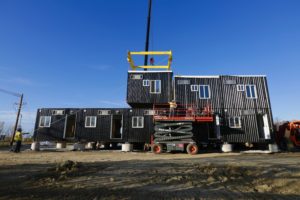July 18, 2018
Myths about Modular Construction
You’ve been reading up on modular construction and have seen opinion piece after opinion piece on this popular construction method. But who do you believe? We truly believe Modular Construction is The Only Way to Build and wanted to address several myths that are out there as you make your decision on which construction method to utilize on your next hotel project.

- Myth: Limited Designs
Contrary to popular belief, modular buildings are as creative, if not even more creative than traditional construction methods. Not all modular buildings are built the same, which allows for design flexibility. Projects differ in size, configuration, and material, depending on the purpose and the designer. The way in which a designer outfits the project and materials he or she chooses, allows for unique buildings both inside and out. The designer is able to spend more time designing since a factory can take those designs and bring them to life faster than traditional construction methods would.
- Myth: Lower Quality
Today’s modular construction processes and techniques provide for a higher-quality build process vs traditional construction. When performing the work inside a factory environment, several quality-assurance programs are in place that assure each module exceeds the customer’s stringent standards. If a module does not meet the standards set forth by a customer, it is corrected at the factory before it gets to the job site – this isn’t possible with traditional construction. Modular buildings adhere to higher quality control standards as they are inspected inside the factory and at the jobsite. Traditionally built buildings are only inspected once, onsite where it can be difficult (and time-consuming) to make changes. In addition, all the materials used to build the modules are stored indoors and are not subjected to weather issues (wetness, cold, etc.).
- Myth: Temporary
Although some modular buildings are used for temporary purposes such as classrooms, administrative spaces, and housing, the advancement of modular construction techniques within the past few years has allowed modular construction to open its horizons. Today, modular construction is being used for many projects including hotels, multi-family apartment complexes and student housing. With modular construction the possibilities are endless.
- Myth: Not Sustainable
Modular buildings are built using the exact same materials as traditional buildings such as steel. But despite using the same materials, modular buildings are in fact more sustainable than traditionally built structures. When you build modular, you build in a factory where tight controls are in place to limit material waste by only ordering and using exactly what is necessary to get a project done. Less waste is great for the environment and can cut down on any “fudge” numbers a traditional contractor must build into their proposal.
- Myth: Sound Proofing Issues
Some people mistakenly think modular buildings have sound proofing issues, but this myth is easily dispelled. Modular construction provides a high level of acoustic separation because each module has separate floor, ceiling and wall elements, which prevents direct transfer of sound along the members. Moreover, additional sound attenuation can be achieved by utilizing sound batt insulation, acoustical mats, and other products. If sound proofing is important to you, one benefit in choosing modular over traditional construction is the inherent sound attenuation achieved by virtue of the necessary modular design.
Do you have another myth you are looking to debunk on Modular construction? Send us a note and find out why Z Modular is The Only Way to Build.
Sources:
Top 5 Myths of Modular Construction